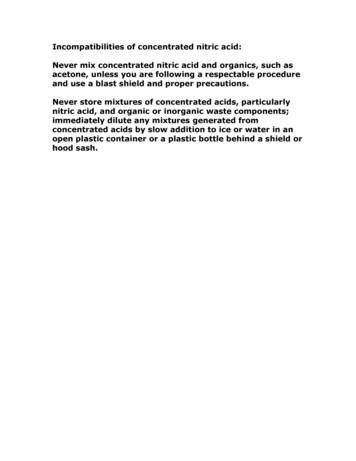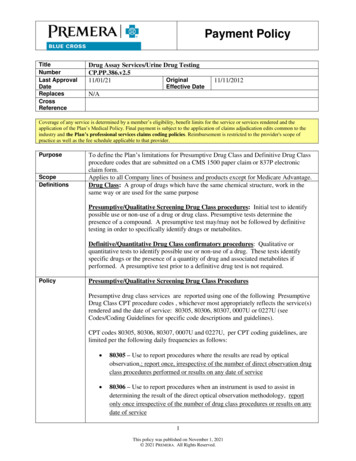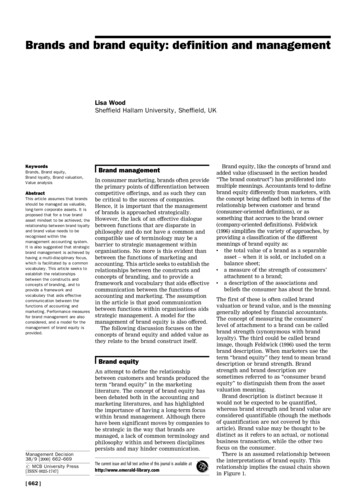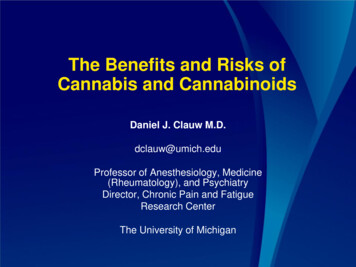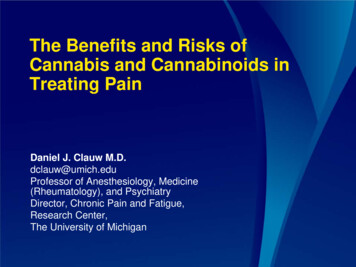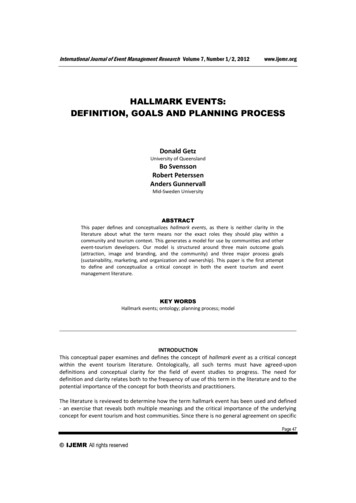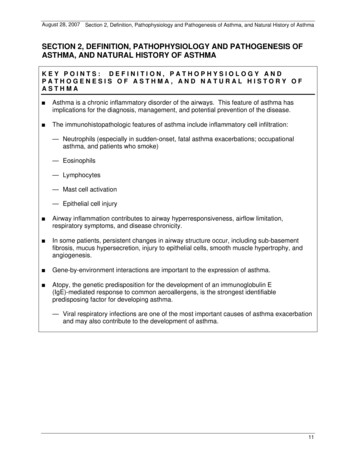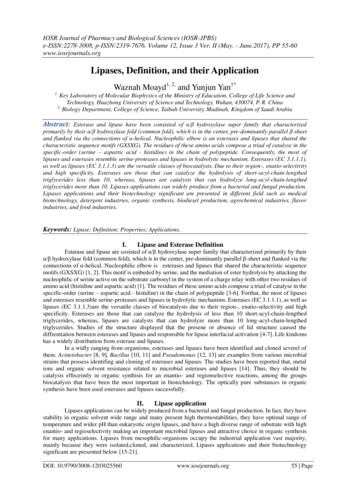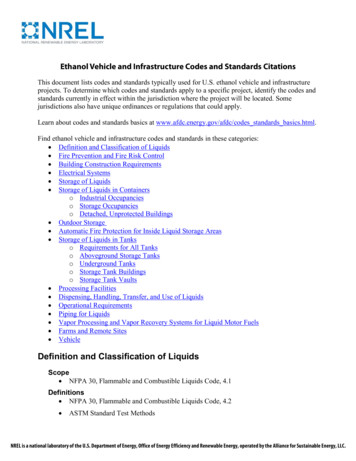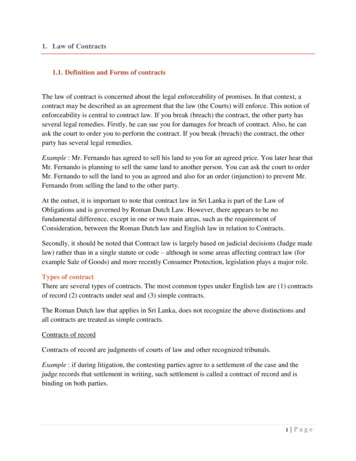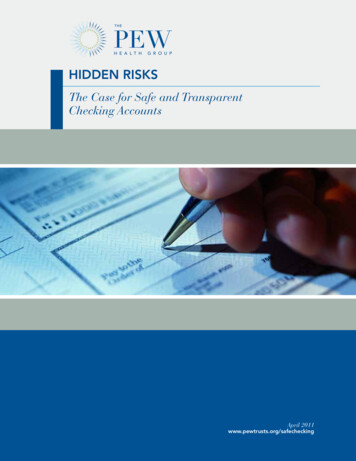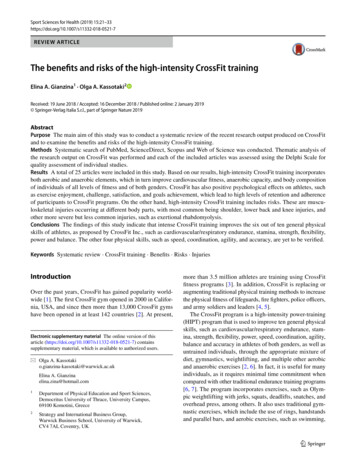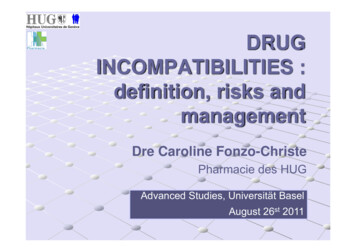
Transcription
DRUGINCOMPATIBILITIES :definition, risks andmanagementDre Caroline Fonzo-ChristePharmacie des HUGAdvanced Studies, Universität BaselAugust 26st 2011
MAIN POINTSWhat are drug incompatibilities?How frequent in the hospital?How can we prevent them?How can we treat them?What should you know?2
MAIN POINTSWhat are drug incompatibilities?How frequent in the hospital?How can we prevent them?How can we treat them?What should you know?3
DrugincompatibilityCASE STUDYICU patient with GVH (graft-versus-host disease)Central IV catheter, 3 lumenIV drugs infused over 24h: Nutriflex Lipid special,Nexium (1.6mg/ml), Sandimmun (1mg/ml) et Trandate(5mg/ml).Other drugs as bolus ou short infusion: Bactrim,Cancidas, Cellcept, Cymevene, Lasix, Solumedrol,TazobacReserve drugs: morphine, Perfalgan et DroperidolNew drug: blood4
DrugincompatibilityWHICH PARTNERS?Solvent excipientsDrug AEnvironment Temperature LightDrug BSolvent excipientsFactors Concentration Time of contactMaterial PVC (DEHP) Silicone 5
DrugincompatibilityWHERE?From: KIK 2.1, BBraun, 20026
DrugincompatibilityWHAT KIND OF REACTIONS?Physico- chemicalreactions: Acid-base reactions (pH) Catheter occlusionSolubility changesEmulsion crackingOxido-reductionConsequences precipitates (visible)coloration (visible)gas formation (visible)pH change (invisible)Ð drug concentration (invisible) Particles emboli (renal, pulmonary)Ð therapeutic effectToxic effect (ex. peroxide)patient7
DrugincompatibilityINCIDENTS IN PATIENTS?Knowles JB et al. JPEN 1989;13:209-13Hill SE et al. JPEN 1996;20:81-87McNearney T et al. Dig Dis Sci 2003;48:1352-48
DrugincompatibilityCEFTRIAXONE- CALCIUMPrescrire 1997;17:506Bradley JS et al. Pediatrics 2009;123:609-139
PEROXIDESHelbock H et al. Pediatrics 1993;91;83-710
DrugincompatibilitypH AND DRUGSAcidic drugsBasic drugslow pH 7high pH 7Amiodarone (Cordarone )pH 4Aciclovir (Zovirax )pH 11AdrenalinepH 3Cotrimoxazole (Bactrim )pH 10Dobutamine (Dobutrex )pH 3Furosemide (Lasix )pH 9Midazolam (Dormicum )pH 4Ganciclovir (Cymevene )pH 9Morphine HUGpH 3.5Omeprazole (Antra )pH 9Vancomycine (Vancocin )pH 3Phenytoin (Phenhydan )pH 1211
DrugincompatibilityACIDIC AND BASIC DRUGSTo be put in solution, salts of active substances are used An acid is soluble in a basic solution Î drug solution is basic A base is soluble in an acidic solution Î drug solution is acidicFrom: KIK 2.1, BBraun, 2002furosemide sodique (pH 9) vancomycine HCl (pH 3)furosemide sodique (pH 9) midazolam HCl (pH 4)Don’t mix or infuse on Y-siteacidic with basic drug solutions!12
TheoryDrugincompatibilitySOLVENT (DILUENT)Appropriate forSolventpHGlucose 5%-20%pH 4.0 - 6.0amiodarone, amphotericine BNaCl 0,9%pH 7.0 - 7.5aciclovir, phenytoin, furosemideFrom: KIK 2.1, BBraun, 2002Be careful with solvent pH !13
TheoryDrugincompatibilityHEPARIN FLUSHINGSolvent:NaCl 0,9% heparine 20 UI/ml !heparine caspofungineÎ precipitationAsk careful what has been added to the solution !14
SOLUBILITY« Pastis effect »DrugincompatibilityCo-solvent and/or adjusting pH can increasethe solubility of drugs in toinclonazepamexcipientCordarone Perfalgan Nexium Phenhydan Rivotril polysorbate (tween)mannitol, phosphate, NaOHNaOH, EDTAglycofurol-75, EDTApropyleneglycol, acetic acidDilution of drugs Î dilution of co-solventsÎpH changeÎ Risk of precipitation !15
DrugincompatibilityCOMPLEXATIONFormation of insoluble calcium-ceftriaxone complexNo administration of calcium and ceftriaxonesame IV line !by thehttp://www.fda.govNeonates: no calcium infusion if ceftriaxone has beenadministered (48h wash out period) !16
TheoryDrugincompatibilityLIPID EMULSIONIncreased risk ofcoalescence:reversible Ð pH Ð conc. AAirreversible electrolytes withhigh valence (Ca2 ,Mg2 , PO43-)Lipid emulsion is not water !17
DrugincompatibilityLIPID EMULSIONOil phase fat soluble-dye(Sudan red III)Lipofundin or Disoprivan Garamycine Phase separation over 24h18
DrugincompatibilityPHOTODEGRADATIONDegradation of drug under light exposition (sun,phototherapy) Store in the darkEx. furosemide, adrenaline, vecuronium Protection during administrationnifedipine, isoprenaline, nitroprussiatelipides (neonatology)19
DrugincompatibilityCORDARONE AND LIGHT 5 mg/ml0.6 mg/mlN.Marcoz 2003, http://pharmacie.hug-ge.ch/ens/travmaitrise/2003 nm amiodarone po.pdf20
DrugincompatibilityCORDARONE AND LIGHTNICU and PICU: 15 mg*BW ad 50 mlStability if conc. 5 mg/ml (patients 15kg)But: No 10 or 20 ml amber syringe on the marketPediatric references: stable over 24h without lightprotectionHUG: No protection, even if conc. 5 mg/ml21
DrugincompatibilitySORPTIONPhysical interaction between molecule andmaterial (adsorption onto surface)Sorption Î loss of drugadsorption to PVC Ex: amiodarone, nitroglycerine, tacrolimusHUG:Flexs Bioren and syringues BD in PPStandard iv-lines in PVCConnecting lines for syrines in PEadsorption to in-line filter Ex. phenobarbital22
DrugincompatibilityLEACHING (DESORPTION)Leaching of DEHP from PVC by cosolventDEHP: diethylhexylphtalate (plasticizer): hepatotoxic, carcinogen, toxic for reproductionfriability of material, particules in solutionCosolvent: castor oil, PEG-35 castor oil,Cremophor, polysorbate 80 Ex: Taxol, Sandimmun, PrografDEHP-free material (NoDEHP) !23
DrugincompatibilityLEACHINGIncrease with: Temperature Lipid content Contact time (storage) Amount of fluidHigh – risk:Preterm neonates and critically ill patient– IV therapy– Parenteral and enteral feedings– Ventilation– Blood transfusion– Long hospital stay , prolonged therapiesSchettler T. 2002http://www.noharm.org/lib/downloads/pvc/DEHP Exposure of Infants.pdf24
MAIN POINTSWhat are drug incompatibilities?How frequent in the ICU?How can we prevent them?How can we treat them?What should you know?25
FrequenceMEDICATION ERRORSÎÎÎÎAdult ward3%1 incompatible drug combinationsAdult ICU7.2 - 18.6%2-4 incompatible drug combinations, 26.3%2potentially life-threatening, 29% no information4Pediatric ICU3.6%5 incompatible combinationsNeonatal ICU14.9%6 incompatible combinations, 59.3% noinformation1Westbrook JI. BMJ Qual Saf 2011; doi10.1136/bmjqs-2011-000089Bertsche T et al. Am J Health Syst Pharm 2008;65:1834-403 Tissot E et al. Intensive Care Med 1999;25:353-94 Vogel Kahmann I et al. Anaesthesist 2003;52:409-125Gikic M et al. Pharm World Sci 2002;22:88-916Kalikstad B et al. Arch Dis Child 2010;95:745-8226
PRIORITY FOR QUALITYIMPROVEMENTBertsche T et al. PWS 2008;30:907-1527
MAIN POINTSWhat are drug incompatibilities?How frequent in the ICU?How can we prevent them? in the wardHow can we treat them?What should you know?28
Prevention: wardTOOLS29
Prevention: wardReference and its abreviationTrissel handbook 14th ed.RefTo ols and their abreviationsCHUV 9.0 cross-tableCHUVKIK 3.0 databaseKIKKing 2008 cross-tableKingNeofax 2007 handbookNeoFPerfysi 2 databasePerfpH 2007 cross-tablepHStabilis 3 databaseStabThériaque 2007 databaseThéTOOLS Evaluation by 2 pharmacists 40 drug pairs usually used in NICUand PICU Trissel’s as gold referenceDe Giorgi I et al. PWS 2010;32520-930
Prevention: wardTOOLSAssessment Î interpretationÎ adapted cross-tables (charts)Î pH- color code (SchaffhausenModel)Main problems: - exhaustiveness- assessment ofdrug pairs31
Prevention: /pha/medicaments/pha phatab rn/DrugProtocols/IVCompatibilities.htm32
Prevention: wardpH COLOR CODEAdult ICU in Schaffhausen (Switzerland) since 10 yearsVogel Kahmann I. et al. Anaesthesist 2003;52:409-1233
Prevention: wardpH COLOR CODEPharmacy wardOn IV-linesVogel Kahmann I. et al. Anaesthesist 2003;52:409-1234
Prevention: wardpH COLOR CODEAbout 78 drug combinations (636 different drugs)Ð Y-site infusion of potentially incompatible drugsVogel Kahmann I. et al. Anaesthesist 2003;52:409-1235
Prevention: wardHUG NURSE EVALUATIONGschwind L et al. ESCP 2010. http://pharmacie.hug-ge.ch/rd/posters/ESCP2010 lg incompat.pdf36
Prevention: wardHUG NURSE EVALUATIONGschwind L et al. ESCP 2010. http://pharmacie.hug-ge.ch/rd/posters/ESCP2010 lg incompat.pdf37
Prevention: wardCHOICE OF NURSE TOOLShould be adapted to the hospital Type of patientsType of medicationsClinical pharmacist presenceLanguageComputerization of prescription, electronicmedical recordÎ « Individualized » tool for each hospital38
Prevention: wardIN-LINE FILTERSPotential difficultiesfor implementation at least two types of filters (0.2 and 1.2 µm) technical aspects (priming, flushing) aseptic risks no filtration for some products blocked filtersÎ Teaching, operating procedures andfollow-up are essential39
Prevention: wardBLOCKED FILTERSDrug incompatibility:Nexium Dormicum Morphine Î Esomeprazole discoloration precipitation in acidic solutions40
MAIN POINTSWhat are drug incompatibilities?How frequent in the ICU?How can we prevent them? in the hospital pharmacyHow can we treat them?What should you know?41
IN VITRO STUDYPrevention:pharmacyHumbert Delaloye V et al. ESCP 2009. ha poster 2009escp compatibilites.pdf42
Prevention:pharmacyIN VITRO STUDYCompatibility lipid emulsions and drugsGranulometry mean size 500 nm % globule 5µm 0.4%Zeta potential measurementpH measureVisual inspection (microscope)43
Prevention:PréventionpharmacyNUTRIFLEX LIPID dazolamOndansetron417 UI/ml10 mg/ml0.8 mg/ml25 µg/ml2.5 mg/ml100 mg/ml50 mg/ml50 mg/ml (amox.)5 mg/ml10 mg/ml10 mg/ml2.5 mg/ml2 mg/mlY-siteCompatibilitywith NPT / 1hCCICCCCCCCCCCY-siteCompatibilitywith NPT / 4hCCICCICICCCCCBouchoud L et al. SFNEP 2009. http://pharmacie.hug-ge.ch/ens/conferences/lb incomp sfnep.pdf44
Prevention:PréventionpharmacyDISOPRIVANStucki C et al. ESCP 2009 http://pharmacie.hug-ge.ch/rd/posters/escp09poster cs.pdf45
Prevention:pharmacyPN: reduced risk of precipitationUse of organic calcium andphosphates saltsPhosphate mmol/L (Na2HPO4)233.544.5567Calcium mmol/L 012PrecipitateZone8101210Calcium mmol/L (CaCl2 or Ca-Glu)11Phosphate mmol/L (G1P)203040501020Stability Zone304050Bouchoud L et al. JPEN J Parenter Enteral Nutr. 2010;4:542-546
MAIN POINTSWhat are drug incompatibilities?How frequent in the ICU?How can we prevent them?How can we treat them?What should you know?47
TreatmentCATHETER RESCUENon–thrombotic catheter occlusions inpediatric patients:Drug precipitatesAcidic drugs0.2 to 1 ml0.1 N HClLipid ResidueBasic drugs1 ml 0.1 NNaOH or Na bicarbonate0.55 ml/kg70% ethanol ,max 3 mlKerner J et al. JPEN 2006;30: S73-S8148
MAIN POINTSWhat are drug incompatibilities?How frequent in the ICU?How can we prevent them?How can we treat them?What should you know?49
TO REMEMBERAcidic drugsBasic drugsSolvent excipientsDrug ADrug BSolvent excipients50
WHICH DRUGS?Always ALONE:ÎBlood and derivates : agglutination and hemolysis risksBe careful WITH:ÎLow and high pH: precipitation risks Î crystal deposit inkidney, lung, liverÎDrugs with co-solvent : precipitation risks Î crystaldeposit in kidney, lung, liverÎLipid emulsions: cracking risks Î fat embolismReduce contact time to a minimum !ÎConnexion near to the patient51
CASE STUDY: resolutionLumen 1(nutrition)Lumen 2(basic pH)Lumen 3(acidic pH) Nexium Trandatecontinuous Nutriflex Sandimmunintermittent Bactrim Cancidas (stopNutriflex) Cymevene Lasix Cellcept Solumedrol Tazobac In-line filter0.2 γm In-line filter0.2 γm Blood (stopNexium for 1h,no filter) Reserve drugsmaterial52
TAKE HOME MESSAGEHospital and clinicalpharmacists canhelp!53
Central IV catheter, 3 lumen IV drugs infused. over 24h: Nutriflex Lipid special, Nexium (1.6mg/ml), Sandimmun (1mg/ml) et Trandate (5mg/ml). Other drugs as . bolus ou short infusion: Bactrim, Cancidas, Cellcept, Cymevene, Lasix, Solumedrol, Tazobac Reserve drugs: morphine, Perfalgan et Droperidol New drug: blood. 4. Drug incompatibility
